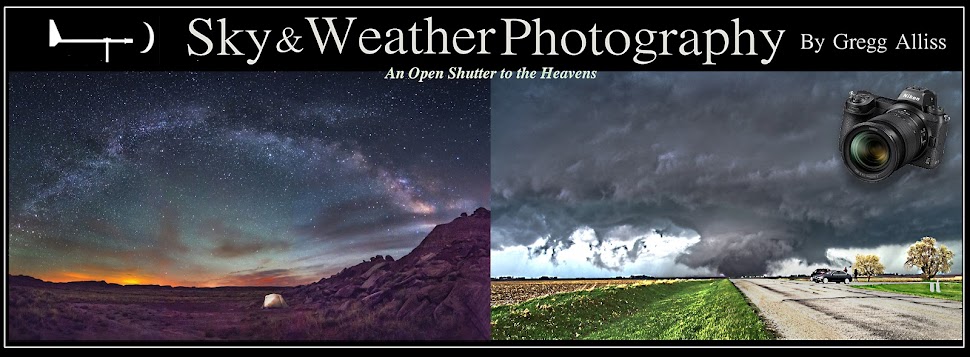NEOWISE, Jupiter, Saturn, Moon & Milky Way
Thursday, July 23, 2020
The Comet NEOWISE (C/2020 F3) made its closest approach to Earth on July 22-23, 2020, and unfortunately from here on it's all "down hill"--the comet is heading back out to space, is beginning to dim, and will fade out completely sometime next month. Because of this, I consider the recent days of clear skies precious. I did not plan it, but in the image above the International Space Station (ISS) glided by just above NEOWISE at 9:53 pm CDT on Sunday, July 19, and I was able to capture it. Location was Lowe Park in Marion, Iowa. The faint star just above the comet's coma is the 7.56 magnitude HIP46351 in the constellation Ursa Major. Three combined images, each a 15 second exposure at f/4, ISO 500 and 70mm focal length.
10:05 pm. This was a test shot from Lowe Park, with a very vibrant band of clouds stretching over the lights of the area. 10 second exposure at f/5.6, ISO 320, 80mm focal length.
10:12 pm. Closeup of the comet. 15 second exposure at f/4, ISO 1000, 70mm focal length.
Next evening, July 20. Skies were beautifully clear upon my arrival at my desired photography location--in rural Shueyville, Iowa, but within a half-hour of the capture of this image at 9:55 pm, the sky had become completely clouded over, and the show was over for the night! Image looks northwest. 10 second exposure at f/2.8, ISO 400, 16mm focal length.
The planets Saturn and Jupiter were in conjunction and at their brightest on the evening of Tuesday, July 21, and their capture was my prime objective for the night. This picture looks southeast from Bowman Woods Park in Cedar Rapids, Iowa at 10:13 pm. Saturn (left) reflected at magnitude 0.10, while Jupiter was much brighter at magnitude -2.74. Two of Jupiter's moons (Callisto and Ganymede) can be seen close and left of the planet. 2 second exposure at f/4, ISO 1250, 70mm focal length.
300mm focal length closeup images of the two planets, with their largest moons included. Lens not powerful enough the resolve the rings of Saturn.
Meanwhile, a bank of clouds to the west had finally lifted, giving me an opportunity to capture NEOWISE. Unfortunately, high humidity was causing heavy condensation on my camera's lens, and this smudgy image taken at 10:50 pm was one of the best. 15 second exposure at f/5, ISO 1250, 70mm focal length.
Wednesday, July 22, 2020. The evening sky started clear and stayed that way! NEOWISE made its closest approach to Earth during this night, with the added bonus of a thin crescent moon included, if one was fast enough to capture them both before the moon set. This is another test shot, more about the moon. The image looks west at 9:37 pm from County Home Road (E34), about .1-mile east of Highway 13, and about 2.5 miles north of Marion, Iowa. The intersection of both roads is illuminated in the background. 2 second exposure at f/5.6, ISO 200, 52mm focal length.
9:56 pm. Same location with Comet NEOWISE included. Moon is setting and low on the horizon at left. 10 second exposure at f/3.5, ISO 500, 18mm focal length.
9:58 pm. 10 second exposure at f/3.5, ISO 500, 18mm focal length.
10:19 pm. Closeup of the comet among some thin passing clouds. 15 second exposure at f/4.8, ISO 2000, 38mm focal length. A shout-out to the couple who unexpectedly joined me at this location last night to view NEOWISE. Good company and conversation!
10:26 pm. 13 second exposure at f/4, ISO 2500, 26mm focal length.
10:31 pm. Getting close to my time to head back home. The sky, though, had another cool feature in store--the Milky Way. Though I was somewhat surprised by its clarity, the location is far enough north and away from the light polluted skies of the Cedar Rapids/Marion area. This panorama image is a merge of four separate photographs, all 15 second exposures at f/3.5, ISO 2500, 18mm focal length. The left part of the image is the northeast sky, and stretches to the southeast at right.
10:33 pm. Bright planets Saturn and Jupiter (center) were still there too, in this image looking SSE. Part of the Milky Way stretches skyward at right. 10 second exposure at f/3.5, ISO 2500, 18mm focal length. Nikon D7200 DSLR camera.



















0 comments:
Post a Comment